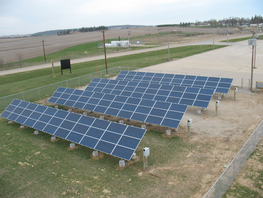 The community solar garden operated by Traer Municipal Utilities
The community solar garden operated by Traer Municipal Utilities Municipal electric utilities in Iowa have provided reliable economic electricity to their communities for well over 100 years. Over that time the industry has evolved from small local generators providing service only during certain hours of the day, to a sophisticated network of large central power stations, renewable generation, high voltage transmission, and distribution systems providing power around the clock 365 days a year. The industry is process of further transformation from new technology, the rise of distributed generation, changing regulations, and changing customer expectations.
As distributed generation grows, municipal utilities will need to address how they recover their costs through rates. Utilities have both fixed and variable costs associated with providing electricity to consumers. Distribution fixed costs, such as poles, wires, meter reading, and office staff, do not change based on the amount of energy sold to customer. However, most municipal utilities recover only a small portion of these fixed costs through the fixed monthly charge, with the rest of the fixed costs recovered through the energy charge ($/kWh).
Customers with DG installed may purchase less energy from the utility, but they still rely on the gird to provide power when their DG does not supply all the electricity they need. DG customers also rely on the grid to send excess energy when their system is producing more than they need. Because traditional utility rates recover much of the fixed costs through the energy rate ($/kWh), and customers with DG purchase less energy from the utility, these customers will pay for a smaller share of the fixed costs than similar customers without DG.
To accommodate DG while recovering the costs of maintaining a reliable system, utilities will need to adjust their rates so that more of the fixed costs are recovered in their fixed monthly charge. This would be accompanied by decrease in the per-unit energy charge ($/kWh). This change will require municipal utilities to educate their consumers on the costs of providing service as well as the benefits and challenges of integrating DG into the system.
Municipal utilities also have the opportunity to facilitate investments in local DG that provide benefits to customers. Traer Municipal Utilities developed a community solar garden that allows all customers to invest in solar PV. In addition, many municipal utilities have invested in local wind projects, by either building wind turbines, or purchasing power through a PPA from a local investor.
IAMU is planning a workshop on November 3rd, in conjunction with the 2015 Energy Conference, to discuss retail rate setting practices of the future. The workshop will provide attendees with tools to design rates that accommodate distributed generation, while ensuring equitable recovery of the utility’s costs. Please watch the Informer and IAMU’s homepage for more information about this workshop.

 RSS Feed
RSS Feed
